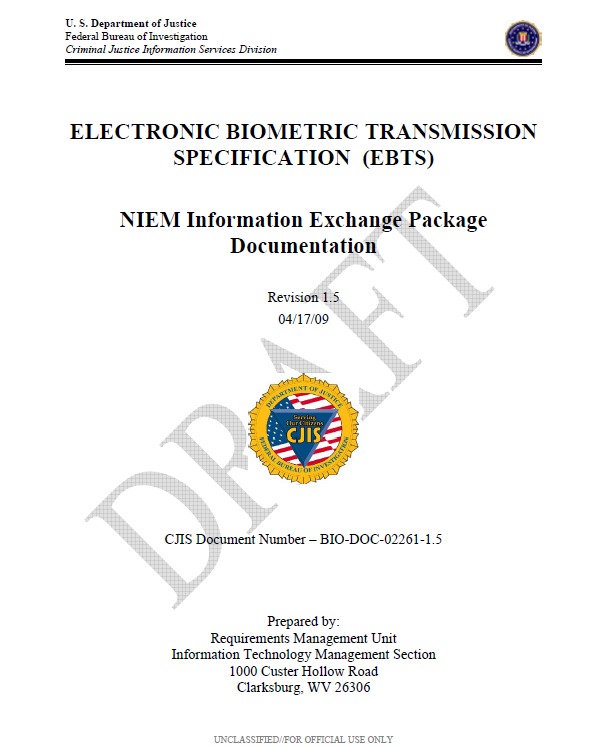NIEM Information Exchange Package Documentation
- 56 pages
- For Official Use Only
- April 17, 2009
1 PURPOSE
The Federal Bureau of Investigation Electronic Biometric Transmission Specification is the method by which the Federal Bureau of Investigation supports the exchange of biometric data used to facilitate the determination of the personal identity of a subject from fingerprint, palm, facial or other biometric information, across criminal justice agencies or organizations that use an Automated Fingerprint Identification System (AFIS) or related systems nationwide.
These biometric specifications are standards for electronically encoding and transmitting biometric image, identification and arrest data. The FBI EBTS is comprised of the biometric standards entitled “Data Format for the Interchange of Fingerprint, Facial, & Other Biometric Information” (ANSI/NIST-ITL 1-2007), which are composed by the American National Standards Institute (ANSI) in correspondence with The Information Technology Laboratory (ITL) of the National Institute of Standards and Technology (NIST). These standards define the content, format and units of measurement for the exchange of biometric information. The FBI EBTS serves criminal justice agencies in the 50 states, the District of Columbia, Puerto Rico, and Canada.
This Interface Exchange Package Documentation (IEPD) covers the FBI EBTS 8.1 XML Data Reference Model.
2 SCOPE
Data in the Federal Bureau of Investigation (FBI) Electronic Biometric Transmission Specification (EBTS) files are exchanged with and for the official use of criminal justice officials of local, state, and federal governments in the U.S. and its possessions and in Canada.
…
5 ADDITIONAL PROVISIONS
5.1 Additional Property Definitions
The basic requirements for EBTS messages are Logical Records Type-1, Type-2, Type-4, Type-7, Type-9, Type-10, Type 13, Type-14, Type 15, Type 16, Type 17 and Type 99 set forth in the ANSI standards which are also applicable to transmissions to the FBI. The FBI-specific requirements for the contents and format of Logical Records Type-2, Type-7, and Type-9 as well as for any special requirements for the other record types, are captured in the business requirements for an EBTS transaction.
5.1.1 The EBTS Transactions
FBI CJIS Division will process the following seven types of fingerprint and four photo transactions from the four main service areas in its electronic environment. There are several types of transactions for each service area that will be accepted by the FBI, the sender must designate the Type of Transaction (TOT) in the Type-1 Record to specify the which process is to be followed.
Ten-Print Services
• Electronic Ten-Print Submissions enable users to submit ten-prints from live-scan booking terminals or card scanners at either the federal, state or local level.
• Remote Ten-Print Searches allow users to search existing records by electronically transmitting fingerprint images or remotely extracted fingerprint characteristics. The user can request specific finger images, up to all 14 fingerprint images, via the Fingerprint Number(s) Requested (FNR) field.
Latent Services
• Electronic Latent Submissions enable the agency having legal jurisdiction of the case, either federal, state or local, to submit latent prints (fingerprints, palm prints, toe prints, and footprints).
• Remote Latent Searches allow the agency having legal jurisdiction of the case, either federal, state or local, to search existing records by transmitting latent print images or corresponding feature sets. The user can set the maximum number of candidate images to be returned via the Number of Candidate’s Images returned (NCR) field.
• Latent Image Maintenance Requests allow IAFIS users to specify transactions (delete or add confirm) related to an unsolved latent file.
Image Services
• Remote Requests for Fingerprint Images enable users to retrieve ten-print images from the FBI Criminal Ten-print Fingerprint Image Master File.
• Electronic Requests to Upgrade Fingerprint Images allow users to request fingerprint images on file at the FBI or to request updates of existing images.
…


